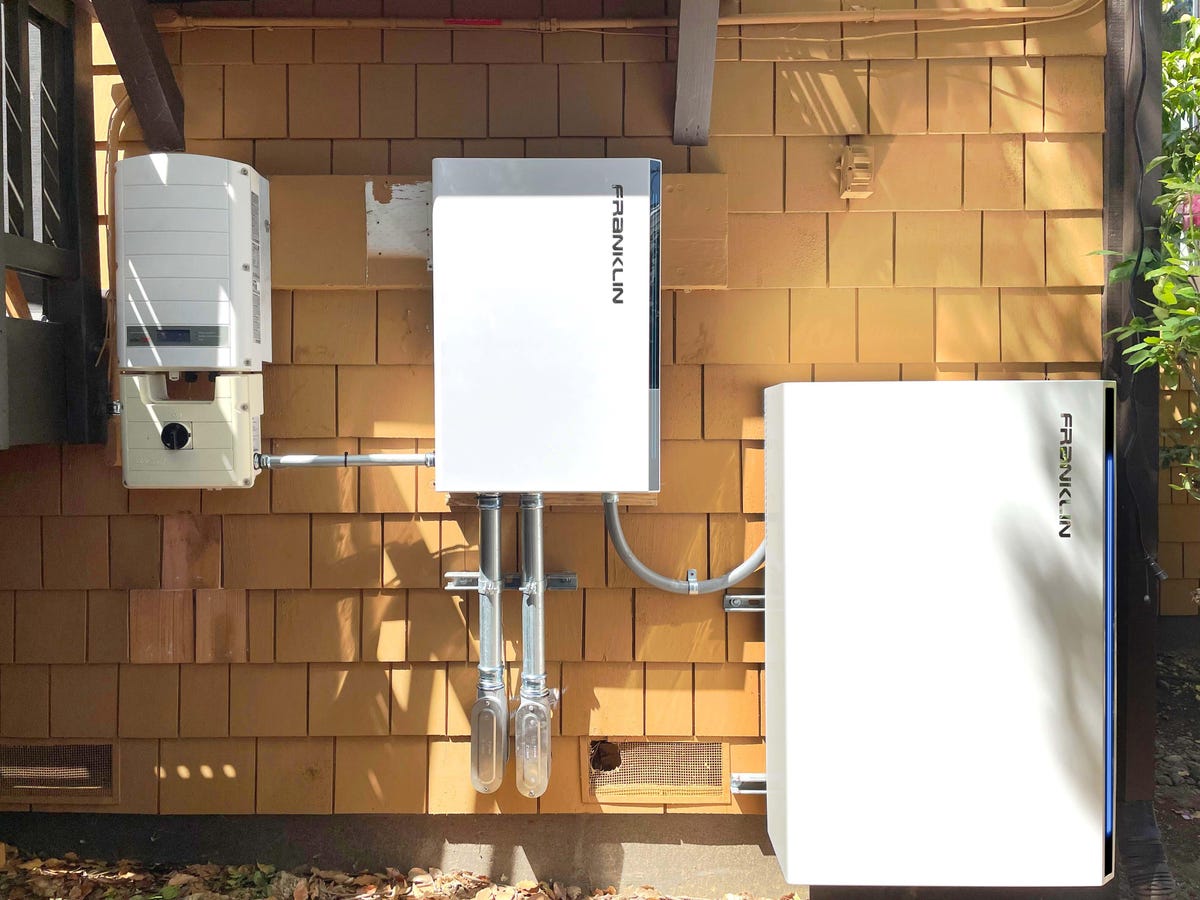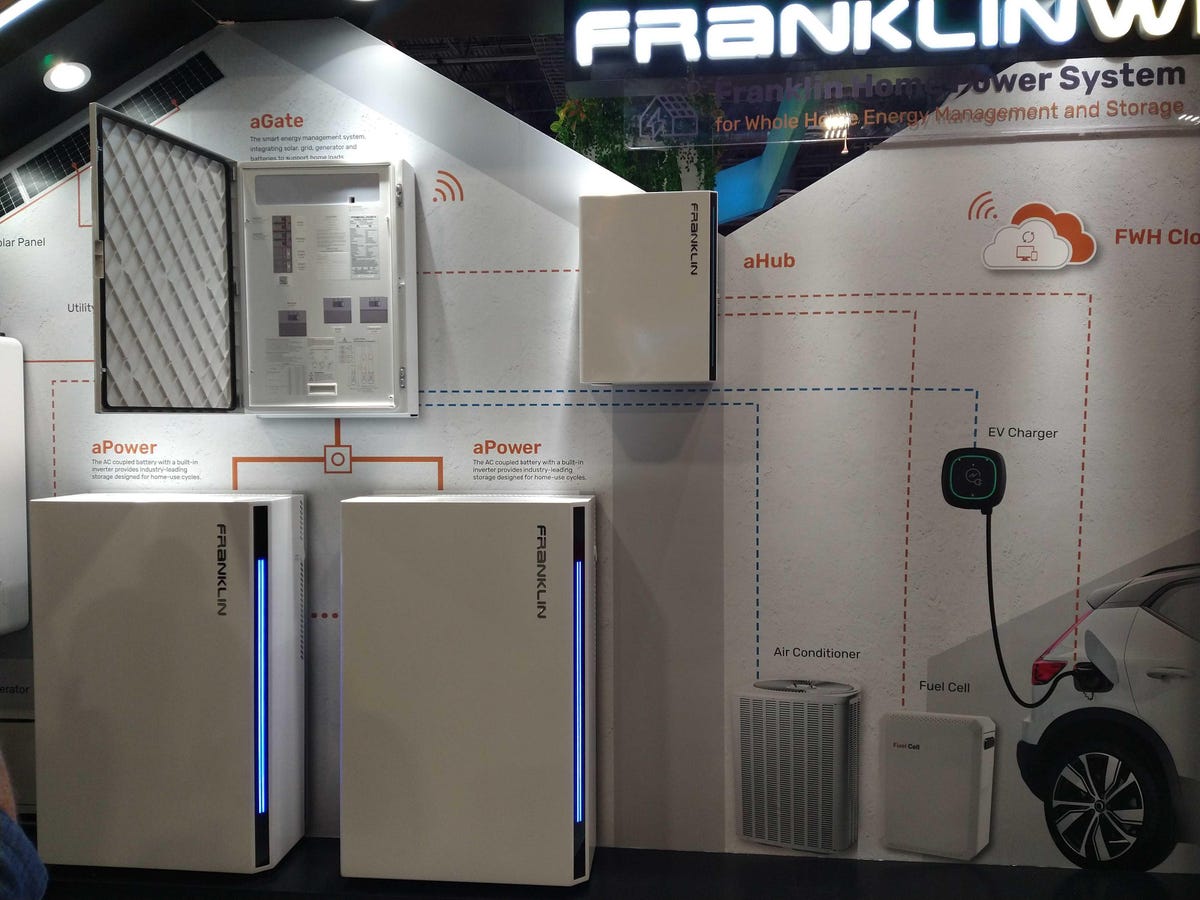
6.5
Franklin Home Power
Like
Can be installed with and without solar panels
Compatible with new and existing solar panel systems
High peak power output
12-year warranty
Don’t like
Lacking modularity
Lower continuous power output
More expensive than other home batteries
The Tesla Powerwall is one of the most popular home battery backups available on the market. And on the surface level, the Franklin Home Power battery could be mistaken as a Powerwall clone, sharing similar specs and functionality. But look a little deeper and you’ll realize that both batteries have too many differences to be considered identical twins.
FranklinWH, the company behind the battery, hasn’t been around that long but is already making a big splash in the battery and renewables space. The company was founded in 2019 and the Franklin Home Power battery was released to market in 2022. For such a new battery, the availability is already very wide. FranklinWH claims its battery system is available in every state.
The Franklin Home Power system has predominantly been all about backup power, powering your home in the event of a grid outage. But recently, FranklinWH has put some focus into time of use rate offsetting as well, helping you save money during times of the day when electricity rates are at their highest.
Can solar panels save you money?
Interested in understanding the impact solar can have on your home? Enter some basic information below, and we’ll instantly provide a free estimate of your energy savings.
“The Franklin system is all about whole-home backup,” Josh Brooks, a member of the service engineering team at FranklinWH, told CNET. “We do have the ability to do things like energy arbitrage, so things like time of use offset. But our main focus is backup. Our main focus is making sure that you still have power, even in an outage.”
We did not conduct any hands-on testing for this review. Batteries are part of a complex home energy system that varies from house to house. Instead, this review is based on publicly available information online from FranklinWH and an interview with Brooks, conducted in September at RE+ 2023, a renewable energy trade show.
Here’s what you should know about Franklin Home Power.
What do I get with a Franklin Home Power Battery?
With Franklin Home Power, you’ll get a large 13.6 kWh worth of energy storage capacity, solid performance specs and a 12-year warranty. The FHP’s peak power output is an impressive 10 kW, but its continuous 5 kW output falls a bit short in comparison to other batteries on the market. We’ll talk more about specs and warranty details below.
Since this is an AC-coupled system, it’s compatible with new and existing solar panel systems. If you don’t plan on getting solar, you can also use the Franklin Home Power battery as a standalone backup power source. However, this system is optimized to work with solar, according to Brooks.
Here’s a quick glance at some of the specs for the Franklin Home Power battery.
Franklin Home Power specs
| Category | Description |
|---|---|
| Usable capacity | 13.6 kWh |
| How many can I install? | Up to 15 units, for a total capacity of 204kWh |
| Round-trip efficiency | 89% |
| Depth of discharge | 100% |
| Peak power output | 10 kW |
| Continuous power output | 5 kW |
| Battery chemistry | Lithium iron phosphate |
| AC- or DC-coupled? | AC-coupled |
| Price | $18,000 |
System components
With Franklin Home Power, you’ll have two boxes on your wall: the aPower and the aGate. The aPower is the larger box that contains the actual battery, as well as the AC-coupled inverter. The battery stores your energy and the inverter converts the DC electricity generated from your solar panels into usable AC electricity for your home.
“The aPower is kind of the powerhouse behind everything. That’s the actual battery system,” Brooks said. “It’s a battery and an inverter in a single enclosure.”
The other box is the aGate, a centralized place to connect everything. Your grid connection, solar connection and energy management components live inside the aGate. The aGate also contains the automatic transfer switch, which switches your system to backup mode when it detects a grid outage.
“It’s a gateway for energy management. Everything can be run through this box without having to add extra hardware,” Brooks said. “We can tie in pretty much all of your different energy sources with the aGate.”
Capacity and modularity
The Franklin Home Power’s capacity is pretty big. One battery (aPower) unit can store 13.6 kWh of energy. If you’re looking for a battery with larger storage capacity, this is worth considering. But it’s not a modular battery, meaning if you end up needing more than 13.6 kWh at some point, you’ll have to buy another aPower unit — this can get very expensive.
Our scoring methodology rewards batteries that are more modular, because you’re better able to size your system to your needs and to upgrade more easily and affordably if your needs increase. But if your energy needs mean a 13.6kWh battery (or a multiple of it) is right for you, modularity doesn’t really matter.
You can install up to 15 aPower battery units for a total energy storage capacity of 204 kWh. And while this is certainly impressive, a single residential home will most likely never need anywhere close to this much storage capacity.

Performance and efficiency
The Franklin Home Power’s performance and efficiency specs aren’t too shabby. Its round-trip efficiency is 89%, meaning 11% of your electricity gets lost on the way into storage. But this is normal — the industry average is about 90%, so it’s not too bad.
The FHP also has a 100% depth of discharge rating, meaning you’ll be able to use all of your battery’s capacity and drain it down to zero without risking harm to the battery. But just because you can drain your entire battery all in one go, doesn’t mean you should. For the sake of preserving your battery’s capacity retention and overall lifespan, try not to drain your battery completely.
Where the Franklin Home Power really shines is its peak power output. This is a measure of how much energy your battery is able to put out all at once without shutting down. Peak power is used for starting up large loads, like your AC, heat or fridge. Batteries also have a continuous power rating as well, which is a measure of how much power it can output continuously.
One Franklin Home Power battery unit has a peak power output of 10 kW and a continuous power rating of 5 kW. The FHP battery’s peak output is very powerful, meaning it can start up large appliances like your AC after a blackout. But its continuous rating is quite a bit weaker than other residential batteries we’ve seen on the market lately that are capable of outputting 7 kW to 9 kW continuously. And while FHP’s peak output is powerful, batteries are only meant to “peak” for a very short amount of time, usually only lasting a few seconds or minutes depending on the battery.
Performance and efficiency details
| Round-trip efficiency | Depth of discharge | Peak power output | Continuous power output |
|---|---|---|---|
| 89% | 100% | 10 kW | 5 kW |
Warranty
With such a large purchase, you’re going to want a good warranty. The FHP’s warranty is solid. The FHP is covered for 12 years. Most batteries are only warranted for 10 years. The expected energy lifespan of the battery is fairly average. The guaranteed 70% capacity retention by the end of your warranty is the industry average, and that’s fine.
Warranty details
| Years covered | Energy throughput | End-of-warranty capacity guarantee |
|---|---|---|
| 12 years | 43 MWh | 70% |
Years covered: This is the length of time your battery system is covered under warranty. After 12 years, your warranty expires.
Energy throughput: This is the manufacturer’s expected total amount of energy (in megawatt-hours) the battery will provide during its lifespan. Once your battery hits its rated throughput, in this case 43 MWh, your warranty expires, even if you still haven’t hit the 12 year mark.
End-of-warranty capacity guarantee: Battery capacity retention shrinks over time. An end-of-warranty capacity guarantee is the manufacturer’s promise that your battery will retain up to a certain percentage of its original capacity by the time your warranty expires. In this case, FranklinWH guarantees that your battery will be able to retain at least 70% of its original capacity by the end of your warranty period.
Customer support
For our battery reviews, we normally look at online customer reviews on the manufacturer’s Better Business Bureau and Trustpilot pages to gauge what sort of experiences people have had with the company’s customer service. FranklinWH is a new company, having only been around since 2022, so information about their service reputation is a bit scarce. The company doesn’t have a Better Business Bureau, Trustpilot, Yelp or Google Reviews page.
While there isn’t enough information available about FranklinWH’s customer service to draw from yet, we can say that the quality of customer support from other battery manufacturers we’ve seen has not been good. But again, it’s still too early to draw conclusions about the quality of customer support you can expect from FranklinWH.
FranklinWH app
Like most home batteries, the Franklin Home Power system comes with an app. The app was designed to be easy to use and understand what’s happening with your energy. “The biggest thing is just to make it simple,” Brooks said. “The idea is, ‘here’s the energy flow, here’s where your power is going.’ Make it simple.”
As far as main features go, the FranklinWH app lets you monitor your solar energy production and your home’s energy consumption, view historical energy data about your home and choose your battery’s operating mode. You’ll be able to pick between three different modes to set.
Backup standby mode is ideal if you want your battery fully charged and you only plan to use it during an outage. If you only want to reserve a certain amount of your battery’s capacity for backup and use the rest to power your home throughout the day, then self-consumption mode is the better option. But if your top priority is saving money and offsetting expensive time of use rates, choose load shifting.
How much does the Franklin Home Power system cost?
Price is not one of the Franklin Home Power’s strong categories. After taxes and installation labor, the average cost of the Franklin Home Power system is about $18,000. This is fairly expensive for a 13.6 kWh battery. Even after taxes and labor costs, you can find other batteries of similar size for under $15,000. For instance, the Tesla Powerwall, a 13.5 kWh battery, costs between $9,000 and $13,000.
But no matter how much a battery costs, we recommend exploring multiple battery options. A lot of installers are certified to install multiple battery brands. Taking the time to get multiple quotes from different installers in your area could save you thousands too.

Is the Franklin Home Power battery my best choice?
Home batteries aren’t one-size-fits-all. No two houses and household energy needs are the same, so the best battery for your neighbor might look different from the best battery for you. The Franklin Home Power battery is compatible with new and existing solar systems. Its also got solid performance and efficiency specs and a good warranty. But it’s also more expensive than other similar batteries available, and it’s less powerful.
Just remember that the best battery for you is one that meets your household’s energy needs and budget. If the Franklin Home Power meets your standards, that’s great. But it’s important to know that there are tons of home batteries on the market to choose from, so don’t limit yourself to just one battery. Take your time and explore multiple battery options from installers in your area, and try to get multiple quotes to see if you can find a lower offer.
How we evaluated the best solar batteries
Each battery is different and isn’t going to be the right fit for every home. Without an on-site inspection, it’s difficult to determine which solar battery is the “best” battery. Because of the complexity of solar panel systems, we aren’t able to do any kind of hands-on testing of any of the solar batteries we review. However, there are objective ways to evaluate and compare these batteries. Here’s how we evaluate solar batteries.
First, we created categories to evaluate the battery’s efficiency, performance, capacity and value. We also gave each category its own weight. Each category’s weight reflects the importance we felt was relevant to the average consumer. Here are the categories and their weights:
- Battery modularity (stackability): 20%
- Warranty: 20%
- Round-trip efficiency: 15%
- Depth of discharge: 10%
- Power output: 10%
- Price: 10%
- Customer reviews: 10%
- Battery capacity: 5%
We looked at more than 15 of the most common batteries on the market and collected the data for each category to compare the numbers. Each battery was given a tier-style rating (from 1 to 5) for each category to see which metrics of each battery were above average (among those on our list), average or below average.
Frequently asked questions
Is the Franklin Home Power battery eligible for the federal solar tax credit?
How do I install the Franklin Home Power battery?
You can contact FranklinWH directly, or look for installers in your area who install Franklin Home Power.







